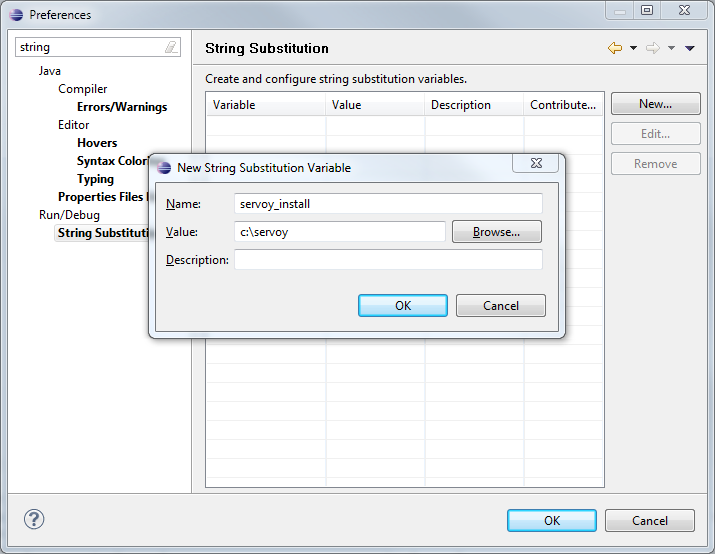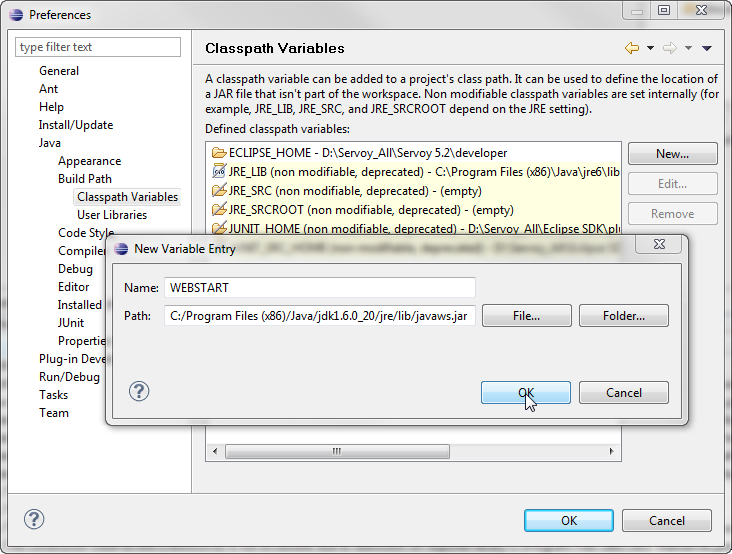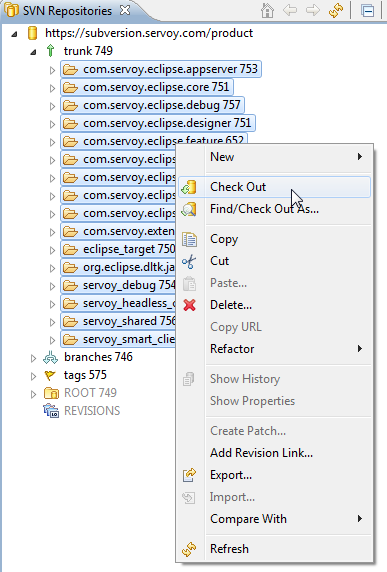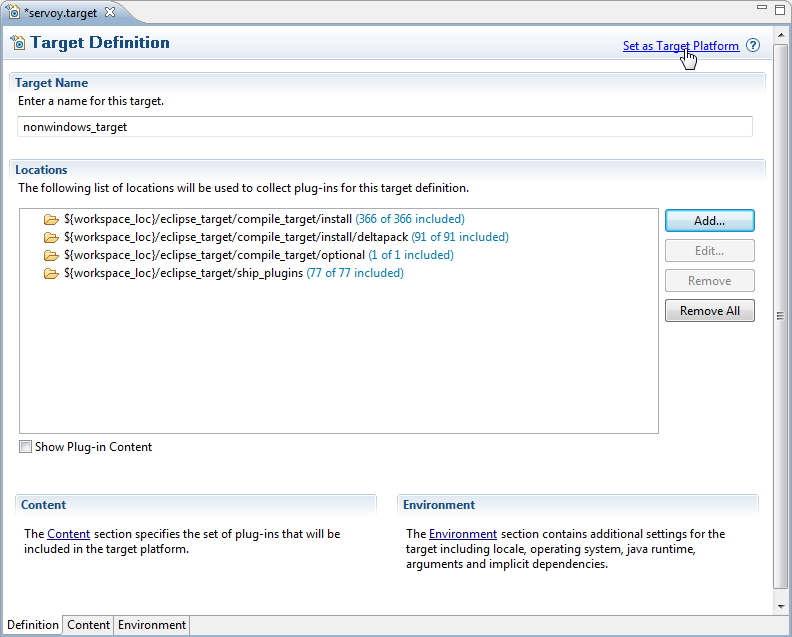Page History
Servoy Developer is a plugin for the Eclipse platform, so to develop the Servoy codebase an Eclipse SDK environment with Eclipse Plugin development facilities is required.
In order to get started with development on one of the open source Servoy projects, the following is required:
- A Servoy Developer installation, with the SQL Explorer plugin installed
- The Servoy Server libraries
- A separate Eclipse environment with the Eclipse plugin development tools installed installed
- Configuration of the Eclipse installation
| Warning | ||
|---|---|---|
| ||
These instructions are for trunk and any future branches, but are not relevant for the Servoy 5.2 branch. For instructions how to setup for Servoy 5.2 development, see Setting Up (Servoy 5.2 branch only) |
| Stoc |
|---|
Quick Start for the Impatient
- Install Servoy Developer
- Install an Eclipse distribution that contains the plugin development tools for Eclipse (PDE), for example Eclipse Classic
- Setup a String Substitution variable named 'servoy_install' which points to the installation directory of the previously installed Servoy Developer
- Create a ClassPath variable named 'WEBSTART' that points to javaws.jar of the used JVM
- Checkout the open source Servoy projects (latest 7xx branch) from the repositories at https://github.com/Servoy/
- Download the Servoy Server libraries from http://build.servoy.com:8080/latest and place them in the 'libs_extra' directory of the eclipse_target project. Download only the files who's name postfix matches the value of the release number in the ClientVersion class in the checked-out source code
- Setup a Target Platform by:
- Opening the servoy.target file, located in the 'eclipse_target' project
- Make sure the entry for '${workspace_loc}/eclipse_target/libs_extra' display '(x of x included)', where x is equal to the number of libraries (.jar files) in the libs_extra directory. If not, force a refresh by selecting the entry, clicking Edit > Finish and then Control-S to save the editor
- Clicking the link 'Set as Target Platform' of the Target editor
- Create a Launch Configuration (and directly start a debug session) by right-clicking the 'Servoy Launch.launch' (or 'Servoy Launch_mac.launch' when on OSX) file in the 'launch_files' directory of the 'com.servoy.eclipse.core' project and selecting Debug as > Servoy Launch (or Servoy Launch_mac when on OSX).
Installing Servoy Developer
An installation of Servoy Developer is required in order to be able to launch Servoy Developer from source code, because the source depends on the directory structure that is present in a Servoy Developer installation.
...
The installer for Servoy Developer can be downloaded after login in at http://www.servoy.com/download. Running Running the installer will install Servoy Developer. For a more indepth description of installing Servoy Developer, see Installing Servoy Developer|.....|||||\
| Wiki Markup |
|---|
After installation, start Servoy Developer and install the SQL Explorer plugin. See \[\] for more information. |
Download & Install Servoy Developer.
Installing Eclipse With The Eclipse Plugin Development Tools
The open source Servoy projects are all plugins for the Eclipse environment, so in order to develop on one of the projects a Eclipse version with Eclipse plugin development tools (PDE) installed is required.
The Eclipse.org download page (http://www.eclipse.org/downloads/) lists a wide range of prepackaged Eclipse distributions. See http://www.eclipse.org/downloads/packages/compare-packages for the overview of what each Eclipse distributions, one being the 'Eclipse for RPC/Plug-in Developers'. Although distribution contains.
One of the offered distributions that includes PDE is the Eclipse Classic distribution. Although the plugin development tools can be installed in any Eclipse environment, the easiest is to download the 'Eclipse for RPC/Plug-in Developers' distribution Classic' distribution and install it.
NOTE: if you want to run the Servoy mobile client, then you also need to install the Google plugin for Eclipse from https://developers.google.com/eclipse/docs/download
Configuration
Start the downloaded and installed Eclipse installation and choose or create a workspace into in which the development on the open source projects of Servoy will take place.
The After startup, the following configuration needs to be done:
Setup a variable: Go to Window > Preferences > Run/Debug > String Substitution and create a new variable named 'servoy_install' with the value of the directory where Servoy Developer is installed.
Create a classpath variable: Go to Window > Preferences > Java > Build Path > Classpath Variables and create a new variable named 'WEBSTART' with the value of of javaws.jar in the Java installation.
Setup a connection to the Servoy
...
source:
Install the "egit" eclipse plugin
Open the
...
GIT Perspective: Window > Open Perspective > Other >
...
GIT
Use the GIT Repositories view to clone the open source Servoy projects (latest 7xx branch) from the repositories at https://
...
...
- Checkout the Servoy projects:
- Expand the tree structure under the newly created Repository Location to the desired version to work on.
- Select all the projects
- Right-click one of the selected projects and select "Check Out" from the context menu
- Setup the Target Platform: In order to ..., a Target platform needs to be setup. The checked out projects alrady contain the setup for different platform:
- Mac OSX
- Mac OSX 64 bit
- Windows 32 bit
- Windows 64 bit
For the correct functioning if the entire environment, including the debugging facilities, the correct target platform needs to be setup.
verschillende target files staan voor de verschillende platformen.
Dit is de meest tricky onderdeel, want als jij bv met eclipse gewoon de 32 bits variant heb geinstalleerd
maar servoy zag dat je een 64bits jvm hebt (dat is in mijn geval zo) dan moet je dus hier de juiste target selecteren
Ben er nog niet over uit hoe we dat nu mooi kunnen doen.
Want bv als je mixed moet je ook nog de juiste jvm (32 bit of 64 bit) geconfigureerd hebben (anders kun je niet debuggen)
Maar je moet dus weten welk platform servoy heeft geinstalleerd als dat bij jou win32_64 is moet je die servoy_win32_64.target file openen
Als je de variable servoy_install goed hebt dan zie je als goed is in de eerste tab bij locations 224 plugins (rond dat getal..) available
nu kun je dus rechts boven in op Set as Target Platform link drukken.
Als het goed is compileerd nu alles in 1x.
...
- servoy-osgi-target
- servoy-eclipse
- servoy-eclipse-tomcat
- servoy-js-engine
- servoy-extensions
- servoy-client
- servoy-mobile
Info Make sure to enable the checkbox "check out projects when clone is complete" in the GIT clone wizard
Download Servoy Server libraries
In order to also be able to start debug clients from Servoy Developer launched from the source code, it is required to use the correct version of several libraries of the Servoy Application Server. The latest version of these libraries can be downloaded from the Servoy build server, located at http://build.servoy.com:8080/latest. Download all the libraries from the subdirectory for a specific branch or for trunk who's name postfix matched the value of the releaseNumber variable in the ClientVersion class of the checked-out source code and place them in the 'libs_extra' directory of the 'eclipse_target' project
Download Servoy Server plugin for running mobile
Please download the latest version of the mobile and mobileservice plugins; these can also be downloaded from the Servoy build server, located at http://build.servoy.com:8080/latest. Download the plugins from the subdirectory for trunk (currently) who's name postfix matches the value of the releaseNumber variable in the ClientVersion class. Copy these over to the the {servoyInstall}/application_server/plugins directory without the postfix (overwrite existing mobile and mobileservice plugins if needed).
Setup the Target Platform:
- Switch to the Java Perspective: Window > Open Perspective > Java
- Expand
...
- the 'eclipse_target' project in the Package Explorer
- Open (double-click) the 'servoy.target
...
- ' file
- Click the 'Set as Target Platform'. This will setup the Target Platform correctly, after which projects will be build and should compile without error.
Installation & setup
- Download & install Servoy Developer.
- Download & install a version of Eclipse with Eclipse Plugin Development features installed (Eclipse SDK)
- Start Eclipse SDK and create a new Workspace
- Install an SVN plugin
- Checkout the Servoy Codebase from SVN
- Add a new target platform (Preferences > Plugin Development > Target platform > add).
- Add a Location under "Locations" of type "directory" and point it to the developer directory of the Servoy Developer installation
- Create a new Debug Launch configuration (Run > Debug Configurations)
- Select the "Eclipse Application" node and click the "New launch configuration" button
- On the "Main" tab:
- Provide a Name
- Specify a workspace location under "Workspace Data" by clicking "File System". Select the workspace containing your Servoy solution projects
- select 'com.servoy.eclipse.core.ide' under "Main" > "Program to run" > "Run a product"
- On the "Arguments" tab:
- Point "Working directory" > "Others:" to the developer directory of the existing Servoy installation, by clicking the "File system" button
- Apply the changes
*Debugging using Eclipse Plugin Development facilities:*
Plugin/bean development using the Eclipse Plugin Development facilities means that Servoy Developer is started from within a Eclipse instance that has the Eclipse Plugin Development features installed (called "plain" Eclipse from now on).
The plugin/bean project is located in the "plain" Eclipse instance. When it's time to debug the code, the Servoy Developer Eclipse instance is launched as a debug process from within the "plain" Eclipse instance.
The Servoy Developer Eclipse instance is a full featured Servoy Developerhat can be used to create/alter solutons, start Debug Clients, create and debug JavaScript code etc. If any code is executed that is part of the plugin/bean project in the "plain" Eclipse instance and it contains a breakpoint, the Java debugger in the "plain" Eclipse instance will be activated and thus the plugin/bean code can be debugged.
Debugging
To launch a debug session the first time, it is required to go through the Debug Configuration dialog:
* Run > Debug Configurations > select the previously created Debug Configuration and press the "Debug" button
On subsequent launches the Debug Configuration will be accessible through the Debug History (available through Run > Debug History or the debug button on the toolbar)
| Tip | ||
|---|---|---|
| ||
Memory settings for the debug session can be set on the "Arguments" tab of the Debug Launch Configuration. It is advised to specify here the same memory settings as applied in the servoy.ini file of your Servoy Developer installation (Default: -Xms40m -Xmx256m -XX:MaxPermSize=256m) |
Creating a Launch Configuration: Last step in the setup of the environment is the creation of a Launch Configuration.
- Expand to com.servoy.eclipse.core > launch_files in the Package Explorer
- Right-click the 'Servoy Launch.launch' file and select Debug As > Servoy Launch
The steps above will install the configuration contained in the 'Servoy Launch.launch' file as a launch configuration and launch a Servoy Developer as a debug session (when on OSX, add the -XstartOnFirstThread argument, to the VM Arguments tab in the launch configuration)
| Note | ||
|---|---|---|
| ||
When starting Servoy Developer from source code, it is most likely that a notification is shown indicating that the Servoy Application Server version should be upgraded. This message can be canceled and ignored. |
When starting a debug session, Servoy Developer will launch with settings of the Launch Configuration. By default the workspace for example that is opened is set to '/workspace', relative to the Servoy Developer installation.
To edit the launch settings, open Run > Debug Configurations > Eclipse Application > Servoy Launch and edit the settings.
Ready: After completing the steps described above, the Eclipse installation is setup correctly to launch Servoy Developer in a debug session:
- Run > Debug (or F11)
Optional Additional Configuration
*Adding other features to the target: *If additional features are required in the Servoy Developer that is launched from source code, for example an SVN Team Provider plugin, an easy way to achieve this is by adding the feature(s) to the target Definition.
- Make sure the feature is installed in a Eclipse installation, doesn't have to be a Servoy Developer installation, can also the the Eclipse SDK from which the development on the Servoy open source projects is being done.
- Open the 'servoy.target' file in teh root of the 'eclipse_target' project
- Click Add > Features > Next
- Point the location to an installation directory of Eclipse. Note that when using a Servoy Developer instance in this case, the
{servoyInstall}/developeris the directory to point to. - Check the feature(s) to be included and press Finish.
- Click the 'Set as Target Platform' link again.
Running Mobile Client From Sources
- Install GWT plugin for Eclipse
- Run 'build_mobile_in_developer' ant task from 'build.xml' of 'servoy_mobile' project (this will create the template war file)
- Refresh Workspace for Eclipse file system to see the war file
- Copy(Overwrite) mobile_xyz*.jar and mobileservice_xyz.jar from http://build.servoy.com:8080/latest to plugins folder of your Servoy install (where variable servoy_install points to). Download only the files who's name postfix matches the value of the release number in the ClientVersion class in the checked-out source code.
- Run Servoy Developer
- From Servoy Developer, export mobile solution to folder:
{myEclipseWorkspace}/servoy_mobile/war - Refresh 'servoy_mobile' project from Eclipse workspace
- From context menu of 'servoy_mobile' project run: Debug as > Web Application (choose index.html as html file)
- Activate service solution in Servoy Developer
- In Eclipse, from Development Mode view, open the provided url in Chrome browser
- If GWT plugin for Chrome is not installed you will be prompted to install it; afterwards the mobile solution will run, breakpoints can be put in java classes of 'servoy_mobile' project



